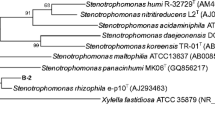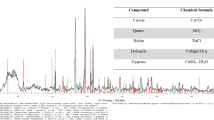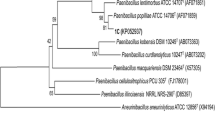Abstract
A biosurfactant producing isolate of Stenotrophomonas maltophilia (BR-12) was isolated from crude oil-contaminated soil from Vadodara oil refinery (India) and characterized on the basis of biochemical tests and identified by 16S rRNA sequencing. It was also assessed for its Pyrene bioremediation potential under submerged conditions in minimal media spiked with Pyrene at 20, 50, and 100 µg mL−1. Analysis of microbial growth parameters revealed that BR-12 grew best at 50 µg mL−1 Pyrene concentration, leading to 87 % degradation of Pyrene within 20 days and production of high amount of biosurfactant (2.2 g L−1). Since biosurfactant production ability of bacteria can play a major role in enhancing its ability to degrade Pyrene, this promising strain needs to be further exploited in bioremediation of PAH-contaminated sites.


Similar content being viewed by others
References
Boonchan S, Britz ML, Stanlye GA (1998) Surfactant enhanced biodegradation of high molecular weight PAH by Stentrophomonas maltophilia. Biotechnol Bioeng 59:482–494
Bushnell LD, Haas HF (1941) The utilization of certain hydrocarbons by microorganisms. J Bacteriol 41:653–673
Chiou CT (1985) Partition coefficient of organic compound in lipid. Water system and correlations with fish biotechnology factors. Environ Sci Technol 19:57–62
Cooper DG, Goldenberg BG (1987) Surface-active agents from two Bacillus species. Appl Environ Microbiol 53:224–229
Das K, Mukherjee AK (2007) Differential utilization of Pyrene as the sole source of carbon by Bacillus subtilis and Pseudomonas aeruginosa strains: role of biosurfactants in enhancing bioavailability. J Appl Microbiol 102:195–203
Dean-Ross D, Moody J, Cerniglia CE (2002) Utilisation of mixtures of polycyclic aromatic hydrocarbons by bacteria isolated from contaminated sediment. FEMS Microbiol Ecol 41:1–7
Edwards U, Rogall T, Blocker H, Emde M, Bottger EC (1989) Isolation and direct complete nucleotide determination of entire genes—characterization of a gene coding for 16S-ribosomal RNA. Nucleic Acids Res 17:7843–7853
Finlayson-Pitts BJ, Pitts JN (1997) Tropospheric air pollution: ozone, airborne toxics, polycyclic aromatic hydrocarbons and particles. Science 276:1045–1052
Gao S, Seo JS, Wang J, Keum YS, Li J, Li QX (2013) Multiple degradation pathways of phenanthrene by Stenotrophomonas maltophilia C6. Int Biodeterior Biodegrad 79:98–104
Gomej KA, Gomej AA (1984) Statistical procedures for agricultural research. Wiley, New York
González N, Simarro R, Molina MC, Bautista LF, Delgado L, Villa JA (2011) Effect of surfactants on PAH biodegradation by a bacterial consortium and on the dynamics of the bacterial community during the process. Bioresour Technol 102(20):9438–9446
Green VS, Stott DE, Diack M (2006) Assay for fluorescein diacetate hydrolytic activity: optimization for soil samples. Soil Biol Biochem 38:693–701
Gurjeet Priyanka, Kothiyal NC, Kumar V (2014) Bioremediation of some polycyclic aromatic hydrocarbons (PAH) from soil using Sphingobium indicum, Sphingobium japonicum and Stenotrophomonas maltophilia bacterial strains under aerobic conditions. J Environ Res Develop 8(3):395–405
Heitkamp MA, Cerniglia CE (1988) Mineralization of polycyclic aromatic hydrocarbon by a bacterium isolated from sediment below an oil field. Appl Environ Microbiol 54:1612–1614
Holt JG, Krieg NR, Sneath PHA, Staley JT, Williams ST (1994) Bergey’s manual of determinative bacteriology. Williams and Wilkins, Baltimore Maryland
Korda A, Santas P, Jenenti A, Santas R (1997) Petroleum hydrocarbon bioremediation, sampling and analytical techniques, in situ treatments and commercial microorganisms currently used. Appl Microbiol Biotechnol 48:677–686
Leneva NA, Kolomytseva MP, Baskunov BP, Golovleva LA (2009) Phenanthrene and anthracene degradation by microorganism of the genus Rhodococcus. Appl Biochem Microbiol 45:169–175
Lowry OH, Rosebrough NJ, Farr AL, Randall RJ (1951) Protein measurement with the folin phenol reagent. J Biol Chem 193:265–275
Makkar RS, Cameotra SC (1997) Biosurfactant production by a thermophilic Bacillus subtilis strain. J Ind Microbiol 18:37–42
Maliszewska-Kordybach B, Smreczak B (2000) Ecotoxicological activity of soils polluted with polycyclic aromatic hydrocarbons (PAHs): effects on plants. Environ Technol 21:1099–1110
Manoli E, Somara CN (1999) Polycyclic aromatic hydrocarbon in natural water sources, occurrence and analysis. Trends Anal Chem 18:417–428
Mersch-sundermann V, Rosenkranz HR, Klopman G (1992) Structural basis of the genotoxicity of polycyclic aromatic hydrocarbons. Mutagenesis 7:211–218
Mukherjee S, Das P, Sen R (2009) Rapid quantification of a microbial surfactant by a simple turbidometric method. J Microbiol Meth 76:38–42
Pandey AK, Chaudhary P, Singh SB, Arora A, Kumar K, Chaudhry S, Nain L (2012) Deciphering the traits associated with PAH degradation by a novel Serratia marcesencs L-11 strain. J Environ Sci Health A Tox Hazard Subst Environ Eng 47:755–765
Somtrakoon K, Suanjit S, Pokethitiyook P, Kruatrachue M, Lec H, Upatham S (2008) Phenantherene stimulate the degradation of Pyrene and fluorantherene by Burrkholdnia sp. VUN 10013. World J Microb Biot 24:523–531
Uyttebroek M, Vermeir S, Wattiau P, Ryngaert A, Springael D (2007) Characterization of cultures enriched from acidic polycyclic aromatic hydrocarbon-contaminated soil for growth on Pyrene at low pH. Appl Environ Microbiol 73:3159–3164
Zafra G, Absalón ÁE, Cuevas MDC, Cortés-Espinosa DV (2014) Isolation and selection of a highly tolerant microbial consortium with potential for PAH biodegradation from heavy crude oil-contaminated soils. Water Air Soil Pollut 225:1826–1844
Acknowledgments
The financial assistance provided by Indian council of Agricultural Research, New Delhi through AMAAS network project and facilities provided by Division of Microbiology, IARI, New Delhi, are gratefully acknowledged.
Author information
Authors and Affiliations
Corresponding author
Electronic supplementary material
Below is the link to the electronic supplementary material.
Rights and permissions
About this article
Cite this article
Singh, A., Kumar, K., Pandey, A.K. et al. Pyrene Degradation by Biosurfactant Producing Bacterium Stenotrophomonas maltophilia . Agric Res 4, 42–47 (2015). https://doi.org/10.1007/s40003-014-0144-4
Received:
Accepted:
Published:
Issue Date:
DOI: https://doi.org/10.1007/s40003-014-0144-4




